The 6 things to look at to date a Cuban box are
[1] Red four-language backstrip;
[2] Green Guarantee stamp;
[3] Union stamps;
[4] U.S. import stamps;
[5] The bottom of the box;
[6] Habanos band and other modern markings.
The 6 things to look at to date a Cuban box are
[1] Red four-language backstrip;
[2] Green Guarantee stamp;
[3] Union stamps;
[4] U.S. import stamps;
[5] The bottom of the box;
[6] Habanos band and other modern markings.
Dating Cuban Boxes
A National Cigar Museum Exclusive
© Tony Hyman
Updated August 6, 2010

Cuban boxes can be dated relatively easily if they were imported into the U.S., thus subject to our ever-changing regulations. If the box of cigars was smoked in Cuba or was exported to Canada, Europe or the rest of the world, the Cubans gave us a few other clues so those can be approximately dated too.
[1] Four Language Backstrip
[2] Guarantee Stamp
A big wide green Guarantee Stamp was authorized July 16th, 1912. That date appears on all similar Cuban Guarantee Stamps up to the present day.
These stamps Guarantee that the cigars in the box were made in Cuba. They are NOT tax stamps. [6805]
This is the first version of the stamp, here used on a box of 100 La Coronas made between 1912 and 1915.
The Cuban Guarantee Stamp underwent a major design change in 1924. It is very easy to date a stamp as 1912-1924 or 1924-1962. The original stamp is entirely in Spanish whereas the newer one is in four languages. If you have only a fragment, look for [1] the line of English text at the top of the stamp; [2] the double line of foreign text at the bottom; [3] the raised panel with the “Para Tabacos Torcidos y Pacadura” text.
The earlier stamps are 6mm longer, printed on a whiter paper and appear to be printed in a darker green ink. Newer stamps have an overall green cast. Both versions are considered ‘bank note quality’ engraving, unlike the stamps produced in the Castro era.
Stamp experts report the 1924 version is 178.5mm and the 1928 printing 172.5mm, the size of the 1912 version. One expert claims it was shorter by 1mm in 1931. ¿Quien sabe?
The Guarantee Stamps of the Castro years (1960’s on) are lithographed, the design is somewhat simpler, and printed in a more olive shade of green ink on cheaper quality brighter white imperforate paper. The words “and cut tobacco” appear at the end of the top line of the stamp sometime during the Castro years. The wording of the lines at the bottom also changes.
Guarantee stamps from the 1st decade of the 21st Century have red serial numbers. On boxes shipped after mid 2009, look for a barcode at the left edge of the stamp instead. Other protections against counterfeiters are in the works.

[3] Union Stamps
1889-1902
By an 1889 order of the King of Spain La Union de Fabricantes de Tobacos, an association of workers in cigar, cigarette and smoking tobacco factories, was granted the right to print a large stamp guaranteeing the Cuban origin of the contents. The earliest version of the stamp mentions cigarros y picadura (cigarettes and smoking tobacco) whereas the later version of the stamp mentions only tobacos (cigars).
Each Union factory was permitted to print their name across the text, creating a daunting challenge to collect one box or stamp from each member.
1902-1912
This half page ad in a 1906 TOBACO JOURNAL calls attention to the latest version of the Union Guarantee stamp, first issued in 1902 under authority of the Cuban republic. Note the addition of the Cuban seal to replace
the arms of the King of Spain.
The stamp symbolized independence from Spain and the American Tobacco Trust that had recently bought 291 brands of Cuban cigar and 85 brands of cigarettes, including such stalwarts as LA CORONA, BOCK and HENRY CLAY. The end of the Tobacco Trust and the introduction of the green Guarantee stamp in 1912 did away with the need for this stamp.
[4] U.S. Import Tax Stamps
For a complete look at import stamps, see top menu.
The design of the import stamp issue of 1879 didn’t change until 1904 though a minor change took place in 1895. The “18___” in the right panel was changed to space for a serial number, printed “No.___.” Also, the 50 denomination was printed in red after 1895 but other colors remain the same. The 25 was nearly 10” long and the larger denominations about 13 inches. Almost all boxes with this stamp are from Cuba and collectible.
In 1904, import stamps underwent major revision, shortened to 4± inches and printed with black ink on white paper. Instead of wrapping around the box like previous import stamps, the 1904 and later issues were usually pasted on the bottom. The 1904 stamp was issued in 25, 50, 100, 250 and 500 denominations, but the large two are rare.
In 1910, denominations were dropped and the stamp completely redesigned. Date is below the central vignette.
In 1931, the design remained the same but the date under the ship was changed, and “inspectors” were now “customs officers.” This issue was used until 1946 when import stamps were no longer required.
[5] Box Bottoms
1887
Bottom of LA MIEL, imported into Boston in 1887.
No place of origin was required on boxes before 1892.
Frontmarks (vitolas) and color marks sometimes appear on the bottom. The pencil ‘scribble’ is the packer’s notation of the color of cigars. It is unusual for the custom’s officer’s cancellation to be as clear or as nicely placed.
[9086]
1893
H. UPMANN box imported into San Francisco in 1893. As of the previous year most goods imported into the U.S. had to be marked as to their place of origin. Note the impromptu stamping of “Made in Havana, Cuba” on the bottom front of the box’s edging. The green import stamp confirms the pre 1895 dating.
[9075]
1892 - 1895
The simple origin stamp, green 1879 import stamp and pink type II Union stamp indicate an 1892 to 1895 dating for this H. de CABANAS y CARVAJAL.
So far, I haven’t found evidence that the US tax officials cared whether cigars were identified as from Cuba or West Indies.
1901 - 1904
The simple West Indies origin stamp, dark blue wide 1901 tax stamp and red import stamp (1895-1904) combine to identify this LA TRAVIATA box as 1901-1904.
[9083]
1904 - 1909
The bottom of this PARTAGAS box carries both stamped and penciled color mark, the remains of a 1901-1909 tax stamp and the import stamp used between 1904-1909. The place of origin is not stamped on the bottom or elsewhere other than the paper labels. Note how the tax man neatly pasted the stamp to cover all the ad copy, including claim to Havana origin.
[6819]
1912 - 1915
The bottom of this LA CAROLINA box has a color mark stamped in conjunction with the origin stamp. The narrower dark blue tax stamp is the short lived issue of 1910-1915, the import tax stamp is the issue of 1910-1931, and the wide dark green Cuban guarantee stamp is the issue of 1912-1924. All that combines to say the box dates 1912-1915.
[6715]
1942 - 1946
The Cuban Guarantee stamp is the 1924-1962 version with the English, French and German text along the bottom. The white customs stamp is the design of 1931-1946. The G tax class, created in 1942, narrows VENUS to 1942-1946.
[6734]
1959 - 1962
Import stamps were no longer required on boxes coming into the US after 1946. Blue US tax stamps were no longer required after 1959. The G Tax Class markings continue for some time past 1960, but it clearly identifies the box as having been imported into the US, not legal after 1962. The date is narrowed to 1959-1962. The wording of the origin mark on this box is not common. The most common wordings are MADE IN CUBA, MADE IN HAVANA - CUBA and HECHO EN CUBA. HECHO EN HABANA is seen rarely. All pre-exist Castro. [6731]
Castro era after 1960
During Castro’s administration the Guarantee stamp underwent some minor revisions, including lighter green ink on inexpensive white imperforate paper. Some minor wording changes were made as well. Some folks make a big deal of Castro’s insistence on “HECHO EN CUBA” replacing “MADE IN CUBA” as the place of origin mark in 1960 but both Spanish and English had been used for decades.
1937
Purchased retail in Havana during Christmas vacation, 1937, this box was hand carried into port at Key West, where it was stamped by the tax inspector. The tax stamp is Cuban. No Cuban Guarantee stamp was used on boxes sold in Cuba. The oval shaped origin mark seems to have become the preferred form in the 1930’s. Almost all Cuban boxes exported during and after WWII are marked with this style oval reading MADE IN CUBA, MADE IN HAVANA, MADE IN HAVANA - CUBA or HECHO EN CUBA. [6864]
[6] Habanos band on top

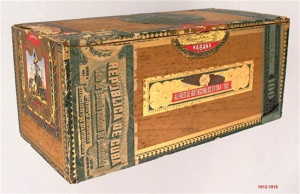

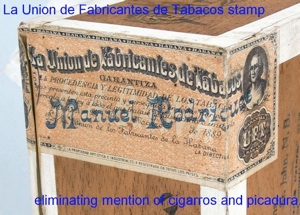
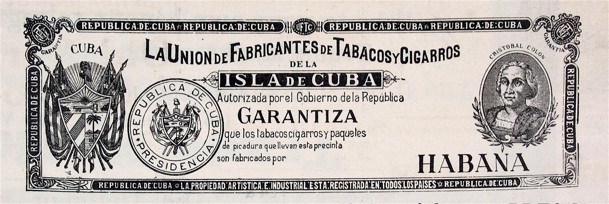
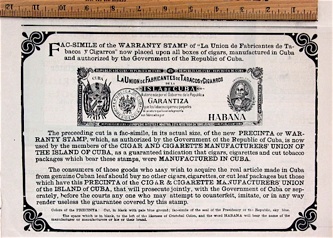
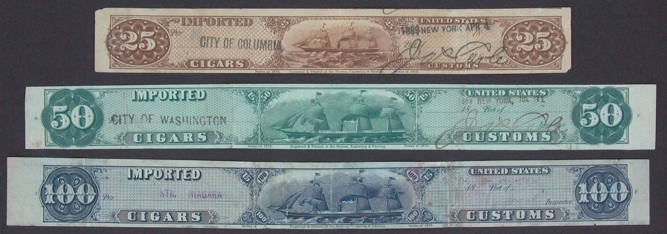
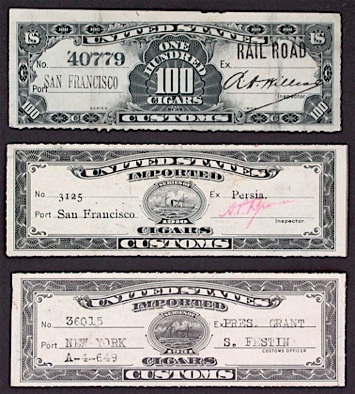
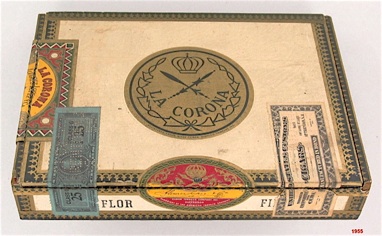
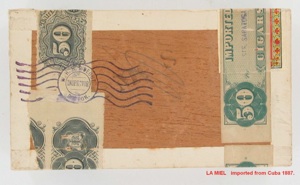
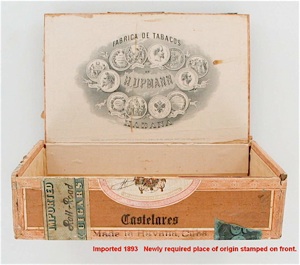
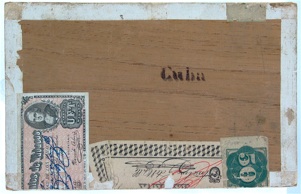
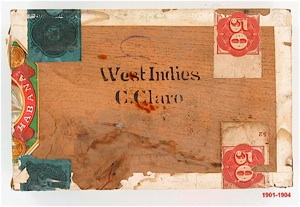
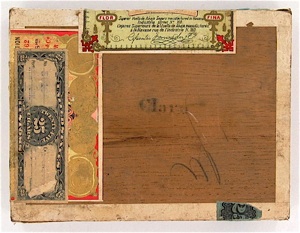
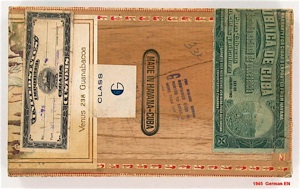
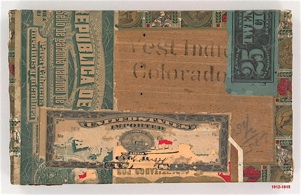
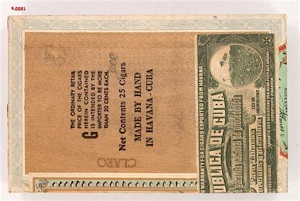
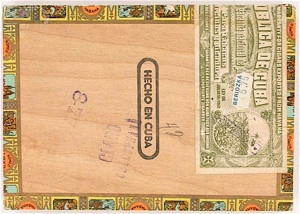
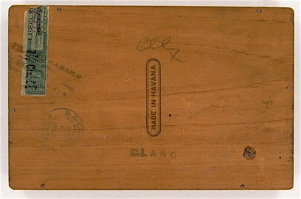

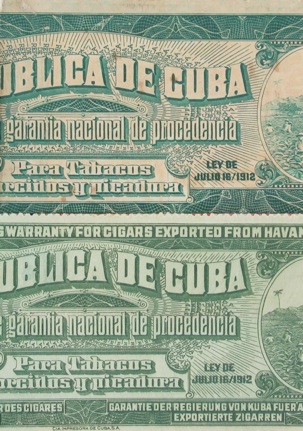
Between 1985 and 1994, Cuban boxes are marked on the bottom with the name Cubatabaco.
1989-2007
If you find the words “Totalmente a mano” (totally by hand) on the bottom of your box it was made after 1989. Boxes before then are not marked in that way.
1994-2007
From 1994 to the present, box bottoms are marked Habanos SA.
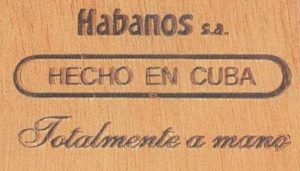
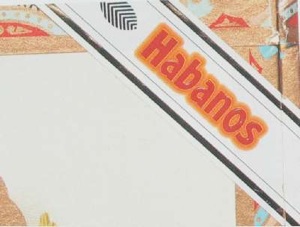
1994-2007
In another of many efforts to thwart counterfeiting, the name of the official exporter of Cuban cigars, Habanos SA, appears on a band angled across the top right of Cuban boxes of cigars made after 1994. Boxes made in sizes and shapes other than standard may have the band in other places on the top of the box. Slide top boxes, for example, often have the Habanos band on the lower left.

The reference to the “Office of the Provisional Governor” suggests this very rare version of the Cuban Guarantee stamp was used during the first American Occupation of Cuba 1898-1904, though possibly only on brands manufactured by the Tobacco Trust. This copied from the bottom of a La Rosa Aromatica box not in the NCM.
Photo courtesy of Jan Goerhardt, the Netherlands.
If you find a white “United States Customs” stamp prominently displayed atop a box they are not import stamps for Cuban cigars. The stamps certify they are domestic cigars made in Bonded Warehouses in Tampa, Trenton, Philadelphia, New York, New Orleans or Tampa. LA CORONA pictured here was made in Trenton, NJ, as were most of that brand.
These customs stamps are called “Bonded Warehouse stamps,” are dated between 1913 and 1954, and found in a selection of sizes and interesting texts which describe the type of tobacco and the process used to make the cigars. The dates on the stamp are NOT the dates of the cigars. More detail about these is found in the exhibit of import stamps.